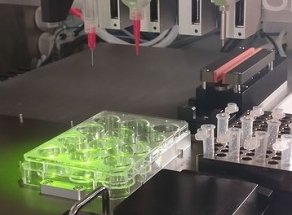The Institute for Technology-Inspired Regenerative Medicine (MERLN) at Maastricht University in the Netherlands works to be a leader in the biomedical engineering field by training an interdisciplinary generation of scientists and conducting innovative research. The institute is on a mission to maximize public outreach in the field through the development and commercialization of important research, and its vision is focused on ambition, infrastructure, and knowledge sharing.
 That is why MERLN is happy to announce that it will be starting a collaboration with Canada-based Aspect Biosystems, one of the major biotechnology companies in terms of tissue engineering and 3D bioprinting. Aspect is also well known for its microfluidic 3D printing technology, which is helping to pave the way for new advancements in understanding regenerative medicine, fundamental biology, disease research, and developing novel therapeutics.
That is why MERLN is happy to announce that it will be starting a collaboration with Canada-based Aspect Biosystems, one of the major biotechnology companies in terms of tissue engineering and 3D bioprinting. Aspect is also well known for its microfluidic 3D printing technology, which is helping to pave the way for new advancements in understanding regenerative medicine, fundamental biology, disease research, and developing novel therapeutics.
Privately held company Aspect works to strategically partner up with pharmaceutical and biotechnology companies, in addition to academic researchers like the ones at MERLN, in order to develop commercially and physiologically relevant tissues. Aspect then uses these tissues to help speed up the discovery and development of new therapies and drugs.
As part of this collaboration, an RX1 Bioprinting Platform by Aspect will be placed inside Professor Lorenzo Moroni’s Lab at the university. There, Dr. Carlos Mota, the head of bioprinting research, will put it to good use developing 3D bioprinted kidney tissue.
“At Aspect, we are committed to collaborating with leading research groups in tissue engineering and regenerative medicine to realize the broad applicability of our technology. Patients on life-saving, but onerous, dialysis treatment are often found waiting for donor organs that are severely limited in supply. Tissue engineers recognize the potential of their work to alleviate this problem, but kidney tissue is complex and extremely challenging to create,” said Tamer Mohamed, the President and CEO of Aspect Biosystems. “There is also a strong need for suitable pre-clinical in vitro kidney models to predict nephrotoxicity and study disease in the biopharmaceutical industry. By combining the deep expertise at MERLN with our microfluidic 3D printing technology, we are increasing our capacity to tackle these kidney-related challenges head-on.”
The Moroni Lab, a research group that’s part of the MERLN institute, was originally founded at the University of Twente in 2009 for the purposes of using biofabrication to control the fate of cells. Now, it has multiple local and international collaborations.
As part of the terms of the collaborative research agreement with the university, Aspect will now have the option to continue developing and commercializing its products based on the results of its joint research with Maastricht University.
“This is an exciting opportunity. Aspect’s microfluidic bioprinting technology is very appealing from a flexibility and modularity perspective,” said Professor Moroni and Dr. Mota. “At Maastricht University, we have been investing a lot of energy in developing 3D bioprinted in vitro models, which we consider a first immediate step in gaining the knowledge needed for developing regenerative medicine solutions for complex tissue and organ replacement. We already took our first steps in kidney tissue models and we are particularly excited to apply our expertise with Aspect’s platform technology and join forces with their innovative team, which we expect will accelerate our findings and impact in this space.”
Discuss this news and other 3D printing topics at 3DPrintBoard.com or share your thoughts in the Facebook comments below.
Subscribe to Our Email Newsletter
Stay up-to-date on all the latest news from the 3D printing industry and receive information and offers from third party vendors.
You May Also Like
3D Printing Unpeeled: New Arkema Material for HP, Saddle and Macro MEMS
A new Arkema material for MJF is said to reduce costs per part by up to 25% and have an 85% reusability ratio. HP 3D HR PA 12 S has been...
3D Printing News Briefs, January 20, 2024: FDM, LPBF, Underwater 3D Printer, Racing, & More
We’re starting off with a process certification in today’s 3D Printing News Briefs, and then moving on to research about solute trapping, laser powder bed fusion, and then moving on...
3D Printing Webinar and Event Roundup: December 3, 2023
We’ve got plenty of events and webinars coming up for you this week! Quickparts is having a Manufacturing Roadshow, America Makes is holding a Member Town Hall, Stratafest makes two...
Intuitive Machines Debuts $40M Hub for Lunar Ambitions and 3D Printing Tech
Best known for its pioneering work in lunar exploration and its development of the Nova-C lunar lander, Intuitive Machines (Nasdaq: LUNR) has marked yet another significant milestone. The leading space...

































